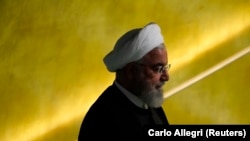If the 2019 opening of the United Nations General Assembly is any guide, the U.S.-Iranian confrontation won’t be morphing into conciliation any time soon. Mixed signals and crossed wires prevailed: the United States levied more sanctions on Iran as President Trump emphasized in his address to the chamber that Washington doesn’t seek “permanent enemies.”
Iran launched a devastating attack on the Aramco oil complexes in Saudi Arabia ahead of President Rouhani announcing the formation of a “coalition for hope” to solve security crises in the region. Thus, deadlock won’t necessarily be turning into détente in the near future for three reasons: a stalemated ladder of escalation; mismatch in demands; and the supreme leader’s powerful veto.
Iran and the United States have engaged in contretemps at the United Nations for decades. Immediately following the Islamic Revolution, few senior Iranian officials participated in the gathering of world leaders for the opening of the General Assembly. Aside from the short-lived presidency of Abolhassan Banisadr who never spoke at the United Nations, Mohammad-Ali Rajai flew to New York when he was prime minister in 1980, but to address a special Security Council debate. While there, he displayed scars on his body from torture for the world to see. There were fireworks when Ali Khamenei became the first Iranian president to address the opening of the General Assembly in 1987 after the United States attacked the Iran Ajr, following the U.S. Navy detecting the vessel laying mines in the Persian Gulf, while Khamenei was on U.S. soil. Fast forward to 2019, Iran’s attacks on Abqaiq and Khurais are only the latest in a long history of a bilateral battle for leverage, livelihood, and legitimacy at the United Nations.
There still appears to be no end in sight to the latest cycle of escalation. After drones and missiles rained down on critical energy infrastructure in Saudi Arabia, the U.S. response was to sanction Iran’s Central Bank, National Development Fund, and Chinese businesses for “knowingly engaging” in shipping Iranian oil in contravention of U.S. sanctions. Additionally, the Pentagon announced hundreds of more troops and military equipment would be deployed to the region.
However, this was a similar response, at least in form, to Iran’s previous provocations. In June when the Iranian government downed a U.S. drone, the Trump administration levied penalties against the Office of Iran’s Supreme Leader and announced it would send around 500 troops to Prince Sultan Air Force Base in Saudi Arabia. To make matters worse, the 500 troops were already part of a previously-announced deployment of 1,000 troops to the region to counter Iran’s malign behavior before the regime even fired on the U.S. drone. While cyberattacks also allegedly comprised U.S. attempts to punish Iran for its destabilizing behavior—both the drone and tanker attacks—the assault on Aramco still happened and there has been no public reporting to date on any further cyber operations.
Deterrence has thus far failed. If a cocktail of sanctions, manpower, materiel, and cyber didn’t change Tehran’s calculus earlier in the summer, it’s unlikely it will move the needle in fall, encouraging the Iranians to become even bolder in their violations of international norms.
In fact, the Iranians continued to escalate while President Rouhani was in New York—on Thursday, the International Atomic Energy Agency (IAEA) announced that Iran had breached the Joint Comprehensive Plan of Action (JCPOA) even further by enriching uranium with advanced centrifuges.
To break the impasse and deter future provocations, one pathway forward for the Trump administration could be capitalizing on British Prime Minister Boris Johnson’s recent comments, where he appeared not to rule out a more kinetic response to this recent Iranian salvo.
At the same time, U.S. and Iranian demands for a diplomatic path forward remain in conflict. Washington is offering sanctions relief for a change in behavior. In contrast, Tehran is offering a multilateral meeting for sanctions relief. Likewise, even if the Trump administration and Iran wind up in the same room, there remain severe incongruities over the exact contours of a future negotiation.
While Iran’s president was in New York, he signaled that more-for-more was required in any follow-on agreement. But Tehran’s vision of “more” isn’t necessarily consistent with Washington’s. Since July, the Islamic Republic has been offering the United States early ratification of the Additional Protocol for the permanent lifting of U.S. sanctions on Iran. But that’s likely a non-starter for the Trump administration, whose entire policy is premised on comprehensive rather than cosmetic overhauls to the JCPOA. Furthermore, Iran refuses to negotiate over the very missile program that the U.S. government demands it constrain.
Lastly, it’s the calculation of the supreme leader—rather than President Hassan Rouhani—which matters in the end. At his closing press conference in New York, President Rouhani indicated that the JCPOA was a baseline off which further, potentially non-nuclear negotiations could be built. But this public line appears inconsistent with the supreme leader’s red line. In March, Ayatollah Khamenei stated: “[w]e will not negotiate over the core values of the revolution. We will not negotiate over our military capabilities.” Yet, it’s limiting the latter which remains a core U.S. objective in its maximum pressure campaign. The supreme leader is Iran’s constitutional commander-in-chief and controls its foreign policy. Protection and promotion of the Revolution—of which missiles and militias form core components—is paramount in his strategic worldview.
Therefore, a standoff, as opposed to a stand down, appears more likely in the aftermath of the 2019 opening of the United Nations General Assembly.








